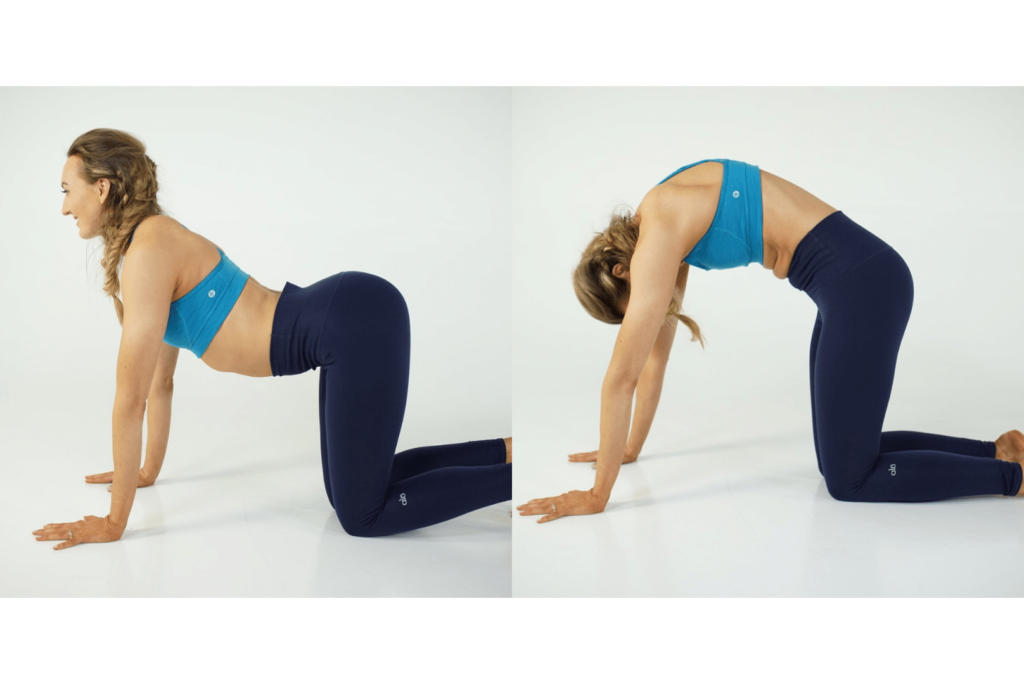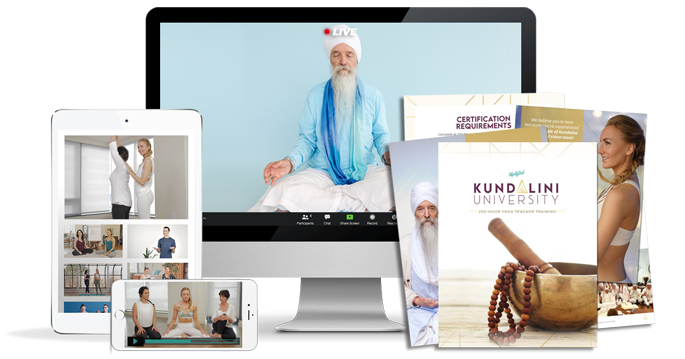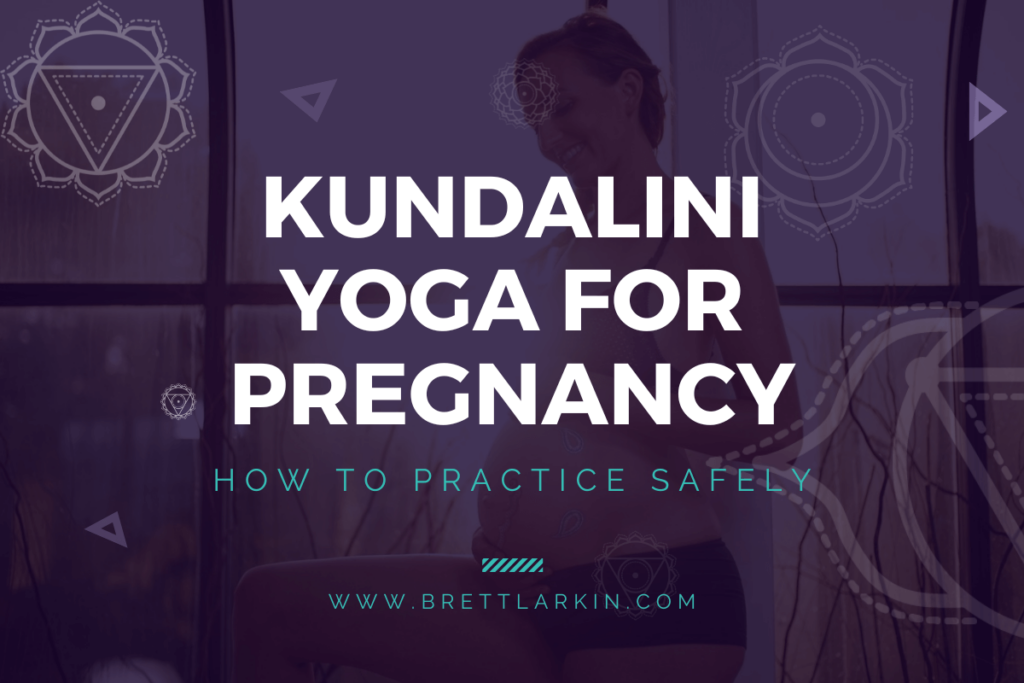Pregnancy is a time of transformation—physically, emotionally, and spiritually.
And if you’re already practicing yoga, you probably know how powerful it can be for easing discomfort, reducing stress, and helping you connect with your baby.
But did you know that Kundalini yoga for pregnancy, when practiced with the right modifications, can be especially supportive? In fact, it’s my go-to pregnancy yoga.
With its emphasis on the inhaling and exhaling, gong meditation, and gentle movement, Kundalini yoga offers a unique toolkit for expecting moms and your pregnant body.
As a form of prenatal yoga, it helps balance energy, strengthen intuition, and cultivate a deep sense of calm—all of which are essential as you prepare for birth and motherhood.
Let’s explore how to adapt Kundalini yoga safely during pregnancy so you can experience its full prenatal yoga benefits while honoring your changing body.
Kundalini And Pregnancy

Kundalini is a powerful yoga practice that combines breathwork, movement, and meditation to awaken energy and deepen self-awareness.
For pregnant women, it can help balance emotions, reduce stress, and strengthen the nervous system—all essential for preparing for childbirth. With proper modifications, Kundalini yoga supports a healthy pregnancy by promoting relaxation, boosting vitality, and enhancing the connection between mother and baby.
When I was pregnant, I loved doing a stretch pose or a Kundalini kriya. Personally, I found yoga was not only safe but incredibly beneficial. It helped me really get in touch with my lungs, which allowed me to be all the more present during my unplanned, at-home birth to my first baby boy. I wasn’t jumping into a shoulder stand, but I was doing leg lifts and helping to strengthen my pelvic area through exercises that didn’t build up too much fire in my belly. Instead, I used Kundalini as a way to release tension, from my head to my knees.
The key is to move at your own pace and trust your inner wisdom. If you have medical complications, it’s always important to consult with your doctor first, before trying any new exercises, including these ones, especially if your baby is in the breech position.
When adapted to honor the changing body of pregnant women, the following exercises offer a unique way to stay centered, reduce anxiety, and tap into deep inner strength.
Most importantly, it’s about trusting your intuition—listening to what feels right, embracing the shifts, and allowing the practice to support you through every stage of pregnancy.
By focusing on gentle kriyas and meditation, moms-to-be can cultivate resilience, trust in their bodies, and embrace the journey of pregnancy with confidence and grace.
Can you do kundalini yoga while pregnant?
Yes, you can practice Kundalini while pregnant, but it’s essential to modify certain kriyas and postures to ensure safety.
Kundalini’s focus on deep breathing and gentle movement makes it a powerful tool for reducing stress, increasing energy, and strengthening the mind-body connection during pregnancy.
Avoid intensity, like Breath of Fire, deep abdominal contractions, or poses that put pressure on the belly. Be mindful of your abdominal area and don’t apply pressure to your belly in any way. Don’t do poses like bow pose or strong leg lifts. Avoid sat kriya or sat nam. Instead, focus on venus kriyas, which are good for fostering emotional bonding, relaxation, and heart-centered awareness, especially when practiced with a partner.
Avoid breath suspension, as this can cause stress to your baby. Focus on lying and doing exercises that focus on your head and below the knees. Prioritize your child settling and allowing this to be a time to relieve stress. You don’t want a diaphragm lock or navel locks. Instead, these exercises should bring you relief.
Instead, prioritize calming meditations, slow movements, and supportive postures that honor your changing body. Always listen to yourself and consult your healthcare provider before beginning or continuing Kundalini.
Is kundalini good for fertility?
Yes, Kundalini can support fertility by reducing stress, balancing hormones, and increasing overall energy flow.
Its combination of meditation and specific kriyas helps regulate the nervous system, improve circulation to reproductive organs, and cultivate a deep sense of relaxation—key factors in optimizing fertility.
Certain Kundalini practices focus on opening the sacral chakra, which is associated with creativity and reproduction, helping to create a more receptive and balanced state for conception.
As always, consistency and a holistic approach, including a healthy lifestyle, play an important role in fertility.
Take my quiz to learn if YOUR kundalini energy is awakened 👇
Benefits Of Practicing Prenatal Kundalini

Being able to practice Kundalini yoga offers so many benefits, from reducing stress to strengthening your mind-body connection. Studies show that prenatal yoga can help lower cortisol levels, reducing anxiety and improving overall well-being (Journal of Obstetric, Gynecologic & Neonatal Nursing, 2020). Kundalini increases oxygen flow to the womb and supports relaxation. Gentle movements improve circulation, easing common pregnancy discomforts like swelling and lower back pain. Meditation and mantra chanting enhance focus and emotional resilience, which can be invaluable during labor. Here are some key benefits of prenatal yoga poses:
- Reduces stress and anxiety – Meditation activates the parasympathetic nervous system, promoting a sense of calm, especially if you do a pose while lying down.
- Improves sleep – Relaxation techniques help regulate sleep patterns, which can be disrupted while with child and are a cornerstone of a healthy life.
- Boosts energy levels – Gentle kriyas stimulate circulation and increase vitality without overstressing the body.
- Supports pelvic floor health – Modified postures strengthen core muscles to prepare for childbirth and postpartum recovery.
- Enhances the mother-baby connection – Meditation and mantra chanting create a sense of bonding and emotional awareness that you can carry throughout your child’s life.
Remember: Always consult your healthcare provider before practicing, and modify movements to ensure a safe and supportive experience.
Are You Chanting Correctly? Refine Your Tune with Me! 👇

Are You Chanting Correctly? Refine Your Tune with Me!

How To Do Kundalini For Pregnancy

When practicing, it’s important to focus on poses that enhance relaxation, improve circulation, and reduce tension, all while avoiding excessive strain and following yoga modifications for pregnancy. Here are three Kundalini poses that are safe and beneficial during pregnancy:
1. Cat-Cow Pose

- Begin on your hands and knees in a tabletop position.
- Inhale as you arch your back and lift your head and tailbone (Cow Pose).
- Exhale as you round your spine, tucking your chin and tailbone (Cat Pose).
- Move slowly and gently between these two positions.
Variations: Perform the pose in a seated position if being on hands and knees feels uncomfortable.
Benefits: Improves spinal flexibility, reduces back pain, and helps open the chest.
Pro Tips for Teachers:
- Use slow and mindful cues to guide your students into a calm, rhythmic flow.
- Remind students to engage their core gently to support the lower back without overexertion.
- Offer props, like cushions or blankets, for additional support if necessary.
2. Seated Side Stretch
- Sit with your legs crossed comfortably.
- Inhale as you raise one arm overhead and exhale as you lean to the opposite side, feeling a stretch along the side of your body.
- Hold for a few moments then repeat on the other side.
Variations: If seated cross-legged is uncomfortable, sit on a cushion or block for more support. Add a mudra.
Benefits: Opens up the sides of the body, helps alleviate rib and back tension, and stretches the intercostal muscles.
Pro Tips for Yoga Teachers:
- Encourage deep, even breaths to help students relax deeper into the stretch.
- Use variations like seated in Sukhasana (easy pose) or with legs extended if cross-legged is difficult.
- Offer gentle reminders to avoid forcing the stretch, allowing the body to open gradually.
3. Modified Child’s Pose

- Start on your hands and knees, then slowly lower your hips toward your heels, extending your arms in front of you or placing them alongside your body.
- Rest your forehead on the mat or a block.
Variations: Use a bolster or cushion under the chest for more comfort, especially in later trimesters.
Benefits: Relieves lower back and pelvic tension, calms the nervous system, and improves digestion.
Pro Tips for Yoga Teachers:
- Offer props to ensure that the student is comfortable, especially as the belly grows.
- Encourage a deep, calming breath with every exhale to help release tension.
- Check in with students to ensure their knees are comfortably apart to avoid pressure on the belly.
I also have some special modifications for yoga for third trimester.
Final Thoughts
If you’re able to practice Kundalini yoga, it can be a deeply nourishing practice during pregnancy when approached with care and modifications.
If you’re ready to explore how Kundalini can support your pregnancy journey, consider taking one of the next steps with me.
Most importantly, remember to embrace the energy and wisdom within you—your body knows the way!
Next Steps
- Ready to teach Kundalini? Try out 3 free classes from 200-hour Kundalini yoga teacher training.
- Kundalini Yoga doesn’t have to be intimidating or frustrating. Take my Kundalini Demystified class.
Get 3 Free Training Vidoes from our Kundalini University Experience & Certification Program

Next Steps
- Love Kundalini? Refine your tune in (the Adi Mantra) with me in this free chanting masterclass.
- Experience my Kundalini Dance Party and elevate your mood in 8 minutes.
- Enroll in my Kundalini Demystified training course. Let’s demystify the “mystery” of this ancient science and INSTANTLY reap the benefits!











